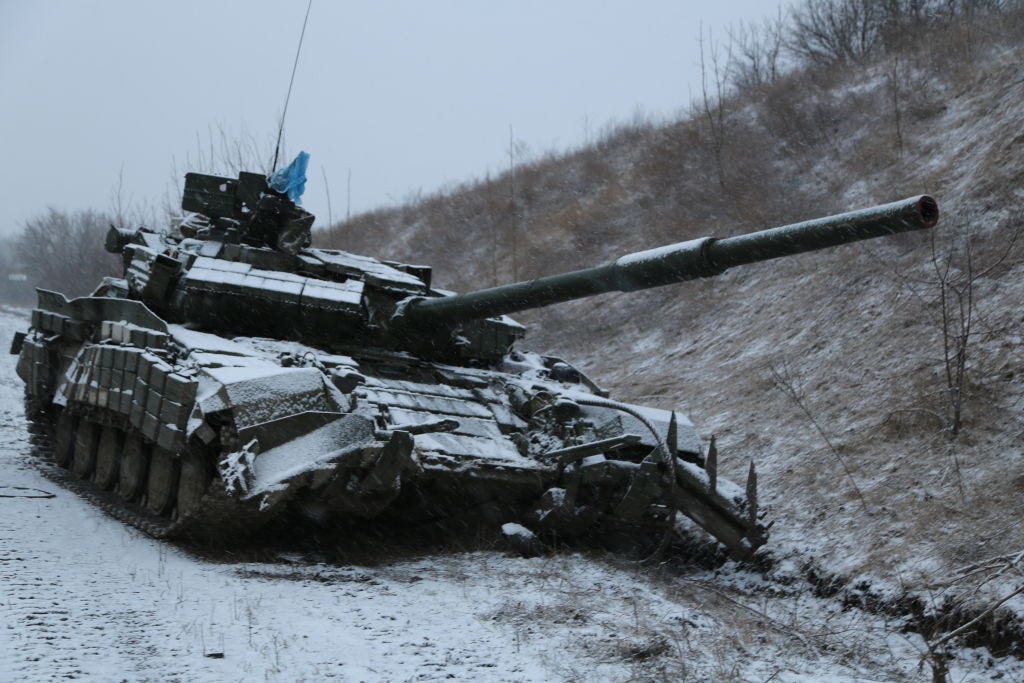Why is the Russian army fighting such a lame war in Ukraine? To paraphrase the infamous quip by Secretary of Defense Donald Rumsfeld about the U.S. invasion of Iraq, the short answer is that Russia went to war with the army they had, not the one they wanted. As it turns out, they didn’t have much of an army at all.
The Pentagon announced yesterday that Russia now has about 190,000 troops on the ground in Ukraine, accounting for nearly the entire force it had amassed on the border before the invasion. With a total of 280,000 soldiers in its army, according to the Institute for Strategic Studies, that means Russia has committed two thirds of its active-duty army to combat in Ukraine. Two thirds.
They’ve pretty much given it all they’ve got, and according to congressional testimony given last week by Lt. Gen. Scott D. Berrier, the director of the Defense Intelligence Agency, their losses have been significant. In the first two weeks of fighting, between 2,000 and 4,000 of Russia’s soldiers were killed in Ukraine. Because the estimate was based on “some intelligence sources, but also open source information,” Berrier explained there was low confidence in the figures, but even if the Russian losses were half of the estimates, they would be shocking.
The Kremlin seems to have taken notice. The Wall Street Journal reported last week that Russia is recruiting fighters “skilled in urban combat” from Syria to supplement its assault on Ukrainian cities. Middle East Institute Syria expert Charles Lister told the Journal that “bringing Syrians into Ukraine is like bringing Martians to fight on the moon,” an apparent sign of desperation on Russia’s part.
There are multiple mysteries about the choices Russia has made in fighting its war to take over Ukraine. Before the invasion even began, I questioned why they were committing such a comparatively small force to their invasion of a country with a population of 44 million and the largest land mass in Europe other than Russia itself. With only 125,000 ground troops, Ukraine’s army is much smaller than Russia’s. But even with that force differential, Russia has managed to take control of only two mid-sized cities in what is now almost three weeks of fighting. The Ukrainian army has fought Russian forces aggressively with guerilla tactics, peppering Russian armored and supply convoys with small-unit attacks using RPG’s and anti-tank weapons, causing the Russian assaults on the Ukrainian capital of Kyiv and Kharkiv, the country’s second largest city, to falter. Neither city has yet been overrun by the Russian army.
Although the Kremlin denies it, Russia has apparently employed large numbers of soldiers described as conscripts who appear to be what we would call raw recruits. There have been reports that some of these relatively untrained draftees have surrendered to Ukrainian forces, telling their captors they were not told they would be fighting a war in Ukraine and believed instead they were on a training exercise. If the Russian plan was to blitzkrieg their way to Kyiv and quickly force a surrender of the Ukrainian army and government, why didn’t they first bomb the city with their powerful air force and use crack first-line ground troops to take the city? As the war grinds on toward its fourth week, your guess is as good as mine.
Russia is about as transparent as a painted-over window about its military capabilities, but it’s beginning to look like the rebuilding and modernization of its military they have said took place in recent years was yet another empty claim by an autocratic government hollowed out by lies and corruption. There have been several reports recently that Russia’s defense budget suffered the same fate as other government programs – monies siphoned off by corrupt bureaucrats and senior military figures looking to renovate their dachas and whole programs that were more fantasy than reality. Which might explain why so many tanks have been left parked by the sides of roads with failed engines or broken parts that couldn’t be replaced. Many of the tanks abandoned and destroyed in the war so far have been T-72’s, a model that first entered the Russian arsenal in 1969, some of which have been refurbished and updated over and over since then. It’s not a modern weapons system you would think one of the world’s most powerful militaries would count on when deciding to invade a country the size of Ukraine.
If the Russian strategy was to overwhelm the weaker Ukrainian military with speed and superior firepower, they have failed spectacularly. The tactics used by the Russian army have been just plain bewildering. The famous 40-mile long convoy from Belarus that was stalled north of Kyiv two weeks ago has only in the last few days begun to move around the western edge of the city, and it has been diminished by repeated Ukrainian ambushes. At one point, the Russians moved their tanks into woods along the roads in an attempt to hide from Ukrainian raiders. The tactic didn’t work. The convoy took significant losses as it slowly made its way south.
The attack on Kyiv from the east has been just as confused and ineffectual. Yesterday, small Ukrainian combat teams attacked a Russian armored column outside of the town of Brovary, about 16 miles northeast of Kyiv. The Russian tanks were moving down a road bunched together and out in the open, making them easy targets for the Ukrainian fighters. Rob Lee, a senior fellow at the Foreign Policy Research Institute and an expert on Russian defense policy, told the Washington Post that “They were not ready for unconventional tactics. They are not sure how to deal with this insurgency, guerilla-warfare-type situation. It’s kind of bizarre…Kyiv is the decisive mission, the decisive objective, and yet they are sending in some very old [tanks] to take it.”
So why has the world’s fifth largest military – with the world’s biggest nuclear arsenal – pretty much failed so far? Ukraine is a much smaller country with a much smaller and less well-equipped army. Did Putin simply think that because he is Putin and Russia is Russia, he could sit back in his gilded bunker and order his military to take Ukraine and it would happen just like that? Was it his truly gigantic ego, or was it decades of corruption that stripped Russia’s defense budget and turned its army into an amateurish shell filled with goof-offs and half-wits right out of the movie “Stripes?”
The war isn’t over, but last night on CNN one of its retired-general military experts said from what he had seen of the Russian army’s performance in Ukraine, he figured they had about 10 days to take Kyiv and Kharkiv and other major Ukrainian cities or the whole invasion would fail from lack of supplies and reinforcements. It might take longer than 10 days, but with reports that negotiations are suddenly “making progress,” I think the general may be right.
We may be witness to Vladimir Putin trying to stall for enough time to come up with a face-saving settlement that will enable him to convince his utterly propagandized masses that his “special military operation” in Ukraine was a resounding success. He will grandly order his army to come home to a hero’s welcome complete with flag-waving victory parades and the whole Russian boot-stomping kaboodle. American Big Lie, meet Russian Big Lie. They are truly made for each other.





It appears the Russians are hopelessly losing although the Putin spin machine is doing all it can to create the impression of inflicting grievous harm on American imperialists by sanctioning high profile politicians like President Biden and Hillary Clinton. No more carefree vacations on the shores of the East Siberian Sea.
Meanwhile, Lilia Gildeyeva reportedly quit her job at Putin friendly Gazprom-Media's channel NTV and fled Russia. She submitted her resignation after leaving the country. I would really like to see more of this type of revolt. Like the editor rushing on camera with a handmade sign telling viewers the special operation is a lie.
Excellent post, Lucian. I read an essay about the reasons why Russian logistics are so poor. In short, it's because they are based on rail transport, a fact exacerbated by the Soviet wide-gauge tracks that are almost unique in the world. Their lines have stalled at almost the exact distance from the border regardless of the direction, and the lack of progress has reduced them to shelling residential areas to "break the will" of the people.
Certainly not an impressive display of military strategy, tactics, logistics, technology, or combat capability.